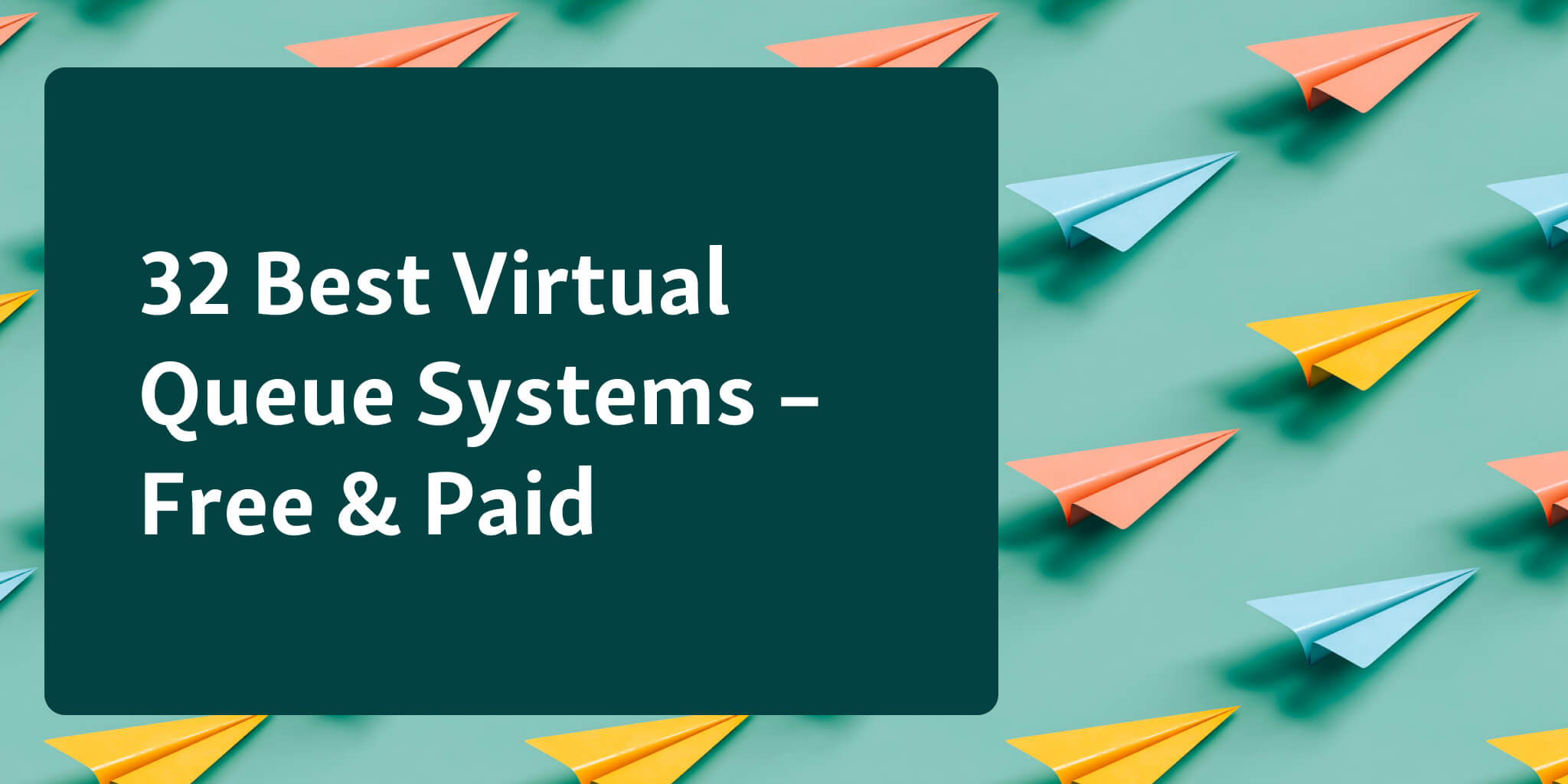For something as essential to businesses as queue management, there aren’t that many guides to queuing and best queue management systems.
After all, how complicated can queue management or waiting line management be? You get customers to stand in line and you manage them, right?
But if you’re looking for ways to engage your customers, keep your staff sastisfied and motivated, and build up your business image, the best path to success lies through queue management.
How does a queue management system and waiting line models work? How do you pick one? How do you make the most out of your business by simply arranging waiting lines?
This post will give you the complete rundown of queue management: from the basics of how it works to actionable tips on how to implement and start using a queuing system in your business.
Let’s get started.
Table of contents
To make this guide more digestible, it is divided into 6 chapters. Feel free to read everything from top to bottom, or skip to the chapter that interests you the most.
Chapter 1: An introduction to queue management

What is queue management?
When we think of queues and waiting lines, the words that spring to mind are “annoyance”, “lots of people” and “waste of time”, mostly because of long wait time.
But let’s put it scientifically: What is a queue? A queue is a line of people waiting for the moment a particular service or product becomes available.
In economic terms, it’s even simpler — a queue is a textbook case of demands exceeding supply. When there are more people queuing up than there are clerks ready to service them, we get queues.
The bigger the difference between the demand and supply, the longer the queue.
So then, what is queue management?
Queue management is a set of principles aimed at controlling customer flow and streamlining the queuing experience.
Although usually we only take into account the effects of long queues on regular visitors, everybody — from customers to manager and top-level administration — benefits from proper queue management.
More on that later. But first, a history lesson.
The history of queue management
Despite what you may think, waiting lines have been with us since the beginning of time.
Some historians say that queues date back to primitive times. When hunters brought fresh meat, everyone had to wait for their turn to take a bite out of it. Most likely, these “waiting lines” resembled animal queuing, where tribe hierarchy determines the order.
Luckily, since then queues became more organized.
As any other part of our lives, waiting lines evolved over time. It wasn’t until the early 19th century that they became a social norm. The first use of the word “queue” dates back to 1837, and it comes from Old French “cue” — a tail.
Read more: The Language of Queuing
What turned queues into an everyday occurrence?
Urbanization, or migration to heavily populated cities. It brought masses of people together — and by masses, we mean more than manufacturing and shops could handle.
What’s more, citizens left their work at almost the same time. This led to peak hours at the shops, and the need to queue up in a structured way.
As queues became more widespread, people started tackling it as a theoretical concept. The current mathematical formulas we use for modeling a queue are greatly influenced by probability distributions.
French mathematician Poisson developed a probability distribution that was later used when developing the queuing theory. This theory was kickstarted by the emerging telephone industry in the early 1900s.
The limitations of manual call switching placed great stress on telephone operators, which called for an efficient management method.
The first developers of queuing theory were Tore Olaus Engset and Agner Krarup Erlang. The latter published his first paper on queuing theory in 1909, developing models around callers who dropped due long wait times.
More than a hundred years later, we’re still there. Today, the average consumer spends five years’ worth of their time waiting in lines. Worse still, people are taking long queues for granted.
How to improve this waiting situation and how can queuing theory help with that?
Let’s dive deeper.

Waiting line models: types and examples
What are the types of queue management?
For this, we need to look at two main parameters of queue management, which are the number of channels (or servers) and the number of phases of service.
Think of channels as the number of stations where you receive service, and phases as the number of steps you need to get full service.
Each parameter can take two values: single (one), or multi (several). Different combinations of channels and phases give us four distinct types of queue management:
Single Channel, Single Phase
A single-channel, single-phase business has only one server. As soon as a customer is attended to, they receive full service. Example: an automated car wash.
Single Channel, Multi Phase
A single-channel, multi-phase business has one server and a multi-step servicing process. Example: retail banking, with different counters for withdrawals, deposits, new accounts, etc.
Multi Channel, Single Phase
A multi-channel, single-phase business has several servers and a one-step servicing process. Example: airline ticket counter with separate queues for business class and economy class passengers.
Multi Channel, Multi Phase
A multi-channel, multi-phase business has several servers and a multi-step servicing process. Example: a laundromat with several washers and dryers.
Read more: The Beginner’s Guide to Queuing theory
Chapter 2: How a queue management system works

The definition of a queue management system
Now that we know what queue management is, we can answer the next question: What is a queue management system?
A queue management system (QMS) is a set of tools developed to manage and analyze the flow of visitors.
This doesn’t sound too difficult, but what does it mean exactly?
Ideally, a queue management software exists to prevent the formation of queues altogether, though its use is not limited to queue managing.
In a way, a queuing app can be considered as a CRM tool, or at least one aspect of it. Joining a queue is one of the first parts of a customer’s interaction with the business. By taking care of this interaction, queue management steps into the realm of customer service.
In other words, queue management system optimizes customer experience.
What makes up a queue management system?
Queuing theory singles out four key components: population of customers, method of arrival, service mechanism, and queue characteristics.
Let’s start from the beginning.
Population of customers
Population of customers refers to the number of visitors you are servicing. Depending on this number, we can describe the population of customers as:
Limited — when there is a known limit to how many customers can be serviced. Example: passengers waiting to board a plane.
Unlimited — when there is no limit to how many customers can be serviced, due to random walk-ins. Example: shopping checkout counters.
Unlimited population of customers is the norm for most businesses.
But how does this work? The global population is still finite, right?
Yes, there is a limited number of people living on the planet. But think about this: how often did you leave the queue only to realize that you forgot to buy something?
You are still the same person, but you are not the same customer.
Your purpose of arrival changes, your preferences change, and your mood and behavior are definitely not the same.
Method of arrival
Method of arrival describes the way in which your customers visit your business.
Consider these questions:
Do customers arrive individually or in groups?
What is the time interval between two successive arrivals?
What is the hourly/daily/weekly distribution of customer arrivals?
Analyzing the method of arrival helps you figure out the arrival pattern.
Service mechanism
Service mechanism describes your services and required resources.
Consider these questions:
How many servers do you have?
Is there a separate queue for each server?
How long does it take for a customer to be serviced?
Similar to the method of arrival, the service mechanism helps you figure out the service pattern.
Queue characteristics
We have defined a queue as a line of customers awaiting products or services. To manage this line, you need to understand the queue discipline (the order of servicing) and the behavior of your customers.
Common types of queue discipline
First in, first out (FIFO) — customers are serviced in the order of arrival, and the customer with the longest wait time is serviced first. This is the most common type of queue discipline.
Last in, first out (LIFO) — the opposite of FIFO: the customer with the shortest wait time is serviced first.
Service in random order (SIRO) — customers are randomly selected from the queue.
Priority selection — customers are selected from the queue based on the established priority process. A patient with a serious injury is attended to earlier than a patient with no injuries.
Read more: Understanding FIFO: First-In, First-Out in Queue Management
Customer behavior
Customer behavior describes how visitors act during the queue-joining phase.
Everyone wants to get patient customers, who join the line and wait however long they need without complaining. But chances are, you can get customers who are:
Balking — after seeing how long the line is, a customer leaves without joining it.
Reneging — a customer joins the line, then leaves without being serviced.
Jockeying — a customer joins the line, then moves to another queue.
Colluding — several customers cooperate, with only one of them waiting in the line.
Read more: Queuing Theory as Applied to Customer Service
Chapter 3: Types of queue management systems

Now that we know what queue management software is, it’s time to look at different types of a queuing system.
Physical management
How it works
Belt barriers, or stanchions, limit the way people can move across the location. This creates an orderly queue, with a low chance of line-cutters or queue-jumpers. You can see stanchions in movie theaters or airports.
Issues
Although it is a simple way of managing a location, it also induces stress in your visitors. In cases where belt barriers are constructed in a labyrinthine way, people may feel themselves trapped.
Basically, belt barriers act as the simplest crowd control tool, but they’re not an effective queue management system.
Read more: Queue Barriers: The Good, The Bad and the Ugly
Sign-in sheet
How it works
Visitors fill in a sign-in sheet template and then give the form to a frontline clerk or manager. You can see sign-in sheets in hospitals, especially in the U.S.
Issues
Sign-in sheets are a cumbersome way of dealing with visitor registration. Handwriting is not always legible, and it takes time to transfer handwritten data to digital databases. Furthermore, there is an issue of privacy with sign-in sheets.
Read more: Why Hospital Sign-In Sheets Are Not Effective
Ticket-based management
How it works
A visitor takes a numbered ticket and waits until the screen displays that particular number. In case of multiple servers, every server is equipped with a separate screen. You can see ticket systems in post offices.
Issues
Ticket-based queuing poses two main problems. Firstly, tickets are tangible objects, which means they can be damaged or lost. Ticket stand may also run out of paper in the most critical moment, preventing people from joining a queue.
Secondly, ticket queuing is a non-personal way of interaction between a customer and a business. Studies show that people react more positively when they hear or see their name, while a numbered system reminds them of a DMV office.
Digital management
How it works
Digital queue management, or virtual queue management, allows visitors to take care of registration themselves by entering data. Customization allows different kinds of data to be entered and processed.
Another benefit of a virtual queuing system is that it allows for remote check-ins.
The last few years have shown that this is an important aspect of any queuing system.
Issues
Since digital queue management is a relatively new technology, people need to grow accustomed to it, and this is true of visitors as well as staff. Digital queuing solutions can also be expensive in the short term, since their value is lasting.
Read more: What Is Virtual Queuing? A Guide to Virtual Queues
Human management
How it works
Human management can work in tandem with all of the above types of queuing systems. Every customer is assigned a personal server, who guides them through every step of the service.
Issues
Although human management is what every business should strive for, it’s an expensive way of servicing your customers. We’ve talked about how population of customers is considered infinite, but this means the number of personal servers should be infinite as well.
Still, a professional greeter might do wonders for your business image.

Choosing the right system
As you can see, there are many different types of queue management system from virtual queuinng to self check-in system, each with its own advantages and drawbacks.
But you don’t need just a queue management system — you want the right one.
How to choose a queue management system that suits your business best?
As a matter of fact, you can answer this question yourself. Ask yourself this:
Do you want to effectively manage your customer flow?
Do you want the cheapest tool possible?
Are you willing to invest your time?
Do you want to manage queues or do you need additional features?
A queuing system is not only a set of tools for crowd control. It is a part of your business image and the first thing your customers will engage with.
It’s almost impossible to count all the benefits of a queuing system for your business, but let’s give it a try.
Chapter 4: The benefits of a queue management system

In this section, we will cover 5 concrete reasons to use a queue management system. After that, we will overview how a queue management system improves businesses at every level — from customers to owners.
5 Reasons to use a queue management system
Eliminates long lines
Long wait times are harming customer experience. A queue management gives your customers access to the services they need without wasting their time. A proper queue management strategy shortens on-site wait times and reduces walkaways.
Boosts staff productivity
A queuing system frees the staff from managing long lines, allowing them to focus on what matters — satisfying customer needs. This makes working environment more fulfilling and creates a sense of accomplishment in employees.
Reduces customer complaints
A queue management software informs customers of their status in a queue, thus making wait times feel shorter. By allowing customers to use their time in a more efficient manner, a queue system builds up customer experience.
Provides valuable data
A queue management system gathers real-time data about the service, wait time, and customers. Analytics provided by a queue management system allows to identify key areas that are in need of improvement.
Improves business image
The use of a queue management system boosts customer appeal of a business. It seems more innovative and in tune with technology. By improving customer engagement, a queuing system turns visitors into customers, and customers into promoters.

A queuing solution is not a tool aimed only at your customers. Let’s see how all participants of a servicing process can benefit from queue management.
The benefit of a queue system for visitors
72% customers agree that valuing customer’s time is the most important aspect of a company. Visitors care about getting serviced as soon as possible, with minimal effort and stress-free.
A queue management system takes care of this by:
Reducing actual and perceived wait time.
Eliminating the possibility of joining the wrong line.
Informing visitors of their real-time status in a queue.
Allowing visitors to spend their queuing time more productively.
The benefits of a queuing system for managers
Frontline clerks and managers care about preventing the chaos of queuing. A queue system helps them by:
Making it easier to manage crowds.
Does not let visitors to register during closing hours.
Giving instructions to visitors.
Improving the working environment.
Evaluating customer behavior.
The benefits of a queue management system for administration
Administration and business owners care about the overall customer experience and the business image. A queuing system proves valuable by:
Tracking employee performance.
Allowing better resource planning.
Measuring the effectiveness of changes.
Making business seem innovative and tech-savvy.
Customers are not the only one who want to have a good experience. A queue system improves the queuing experience for everyone involved and leads to stronger, more personal bonds between the customer and the business.
Queue managemnet and business intelligence
Now, you’re probably thinking, “What is service intelligence?”
It’s not a term you hear every day — not yet, at least — so let’s make things clear.
You may notice that the term service intelligence sounds a lot like business intelligence. That’s because the core concept is similar, with one small difference.
Whereas business intelligence is a process of analyzing data to help make better business decisions, service intelligence uses data to help make better service decisions.
The purpose of service intelligence (SI) is to give you a better, data-based insight into your business. Most of the benefits of a queue management system listed above are part of the Service Intelligence package.
To put it simply, this is how an SI flowchart looks like:
Learn about your visitors.
Manage the queues.
Distribute work between your employees.
Track your performance.
Tailor your service to your customers.
Great customer service begins even before your customers join the line. Service intelligence makes sure you’re equipped with the data you need to balance out supply and demand.
Chapter 5: Implementing a queue management system

Retail Queue Management System
For retail, it’s all about staying in the game in the face of competition. Businesses which cannot manage their lines efficiently are making things easier for their competitors. A queuing system allows to turn wait times into a good customer experience, and visitors into loyal customers.
Healthcare & Hospital Queue Management System
Patients often have to endure long wait times before they’re attended to. This negatively affects the service perception. A healthcare queue management system lets patients see their status in a queue, thus minimising anxiety and frustration.
Queue management in education
Like no other service provider, education institutions have to deal a lot with peak times (enrollment, semesters) and peak hours (breaks, end of classes). A queue management system prevents students from crowding up and makes registrations faster.
Queue management in government
Unlike retail, government structures do not obsess with the quality of their service, since they provide unique services that no one else does. For them, every visitor is an additional cost, and a queue management system for government allows for faster waiting line and service time.
Queue management in telecoms
The traffic in telecoms is not as heavy as in retail, but the service time is longer. Telecoms can use queue management system at their service locations or for internal helpdesks.
The perfect queue management formula
As with any new system, it’s not enough to just install the queue management software. You have to commit to enriching your visitors’ experience.
To make the most out of your queue management system, remember this simple queue management formula. Basically, successful queue management stands on these four pillars:
Greet
Inform
Serve
Analyze

This doesn’t look like too much to ask, but for great customer experience, it’s important that you nail every part of this formula.
Let’s go into detail.
1. Greet visitors
The greet phase includes the arrival and registration of your visitors. You receive all the information — their reason of arrival, name, etc. — that lets you better service them. When set up right, this phase makes customers feel like they are already being serviced.
2. Inform customers
This phase includes the wait time of your visitors. No matter what products or services you are providing, long wait can kill the interest of your visitors. That is why it is important to let them know how long they need to wait and where to go next.
3. Serve customers
When wait time is over, it’s up to you to provide the best customer service. The data that you’ve gathered during the greet phase lets you approach each customer in a more personal way. The serve phase is where all the customer experience magic happens.
4. Analyze queue data
Once you’ve successfully serviced your customers, it’s time to analyze. A queue management system gathers data about the customers and the performance of your business throughout the day. This data helps you locate key areas for improving your queuing experience.
The most important wait experience metrics
When we say “analyze the data”, what kind of data do we have in mind?
There are three metric you need to pay attention to: the average number of customers, the average wait time, and the average service time.
The average number of customers waiting in line
Basically, this metric shows the length of a queue. Short waiting line can be a result of constant customer arrivals or excess number of servers. Long waiting line can be a result of poor efficiency and/or surge in demand.
The average customer wait time
Wait time measures the time customers spend between the arrival and the beginning of service. If too much time is spent waiting, visitors might doubt the competency of the service provider.
The average customer service time
Service time measures the time customers spend being serviced. Long service time is less damaging than long wait time, but it has to be a fulfilling experience for customers. Service time usually ends with a departure of a customer.
Measuring the success of your queuing strategy
Why do you need to calculate your footfall numbers?
Basically, it lets you know whether your marketing efforts are paying off. A queue management system measures the rise or decline in your traffic, allowing you to make more informed business decisions.
If you know how many customers you have on a given day or during peak times, you can properly allocate your work resources and optimize services.
Also, by analyzing footfall and comparing it to sales performance for the same period, you can calculate how many sales opportunities are being missed.
Chapter 6: Frequently asked questions

Does your business need a queue management system?
Yes. A queue system is a versatile system that benefits customers, managers and business owners alike, and it is not limited to queue management but also helps with analytics and customer service.
Will your business benefit from a queuing system?
If your business has queues of customers, then yes. Every business can benefit from a queuing system when balancing out demand and supply.
Even if you don’t experience queues, queue management system can help you with customer experience and data processing.
How much does a queue management system costs?
There is no one concrete pricing model, with different wait line managemnet system providers asking for different prices. When thinking about the price, you have to take into account the long-term effects of a queue management system.
The value of a queue system lies in customer loyalty, brand image, and customer experience that it helps to build up.
While there are free queue management systems, they are not reliable and don't provide the data points you need to keep improving your customer service and experience.
Is it hard to set up a queue system?
No, queue management systems are intuitive and require little to no technical knowledge.
Once the system is set up, I don’t need to do anything?
Yes, you do. A queue management system like Qminder can work on its own, but to take full advantage of its features, you need to make it a part of your service.
Want to give Qminder a whirl? Sign up for free 14-day trial to create the service your customers will want to come back for.






